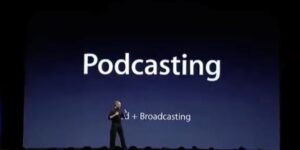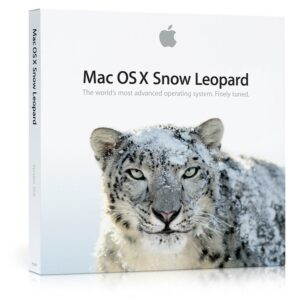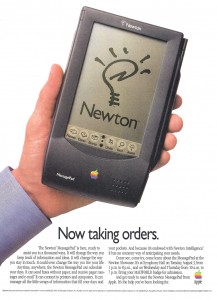Apple
Gil Amelio Ousted from Apple
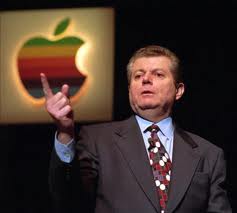
Apple Computer announces the resignation of Gil Amelio as CEO. Having been ousted by the board of directors, Amelio’s departure paved the way for Steve Jobs to re-take the helm of Apple. Ironically, it was Amelio who brought Jobs back into the fold of Apple by purchasing Jobs’ company NeXT to use as the basis for the next Mac operating system.
The Phone That Changed Everything
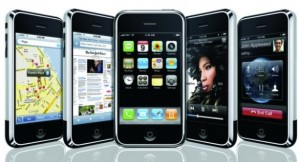 June 29, 2007
June 29, 2007
Nearly 6 months after it was introduced, Apple’s highly-anticipated iPhone goes on sale. Generally downplayed by Old Word Technology pundits after its introduction, the iPhone was greeted by long lines of buyers around the country on that first day. Quickly becoming an overnight phenomenon, one million iPhones were sold in only 74 days. Since those early days, the ensuing iPhone models have continued to set sales records and have completely changed not only the smartphone and technology industries, but the world as well.
Apple Takes Podcasting Mainstream
Apple releases iTunes 4.9, the first version of iTunes to incorporate Podcast subscribing and listening. Podcasting was a growing phenomenon and Apple realized it could both help build the medium and also become the defacto Podcast standard by linking it to its incredibly popular iTunes and iPod platforms. On this date there were 3000 Podcasts available in the iTunes directory. Apple’s move paid off and as of 2021 there were over 2 million Podcasts listed in the Apple Podcast Directory. Apple’s Podcast platform is still considered the standard on which podcasters should publish their shows.
There was an up and coming Podcast directory named Odeo at the time. Given Apple’s move Odeo suddenly became irrelevant. However, the people behind the company shifted focus and soon created a new service called Twttr, soon to be renamed Twitter. Isn’t it so interesting the way technology history weaves itself?
iPhone 4 Goes on Sale
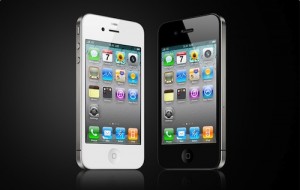 June 24, 2010
June 24, 2010
After a wild lead-up involving a prototype being lost at a bar, Apple’s iPhone 4 officially went on sale. Later the iPhone 4 would then become the subject of the Antennagate controversy. With so much attention given to the phone, it really was no wonder that it went on to set sales records.
Apple Announces Snow Leopard
At their World Wide Developers Conference in San Francisco, Apple announced their next Mac operating system, Mac OS X 10.6, known as Snow Leopard. Snow Leopard, the follow up to Mac OS X 10.5 Leopard, was as the name somewhat insinuated, more of an update to the previous OS than a full blown feature upgrade. Indeed many of the features in Snow Leopard were performance updates and optimizations for 64-bit and mutli-core processors. It was also the first Mac OS to drop support for the PowerPC processor line, focusing only on the Intel processor, which Apple has switched to for their Macintosh computers in 2006. Additionally the footprint of the OS was actually smaller, which would save disk space for users of Snow Leopard when it was released in September of that year.
The Mac Gets Intel Inside
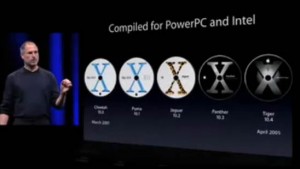
In a keynote address at Apple’s Worldwide Developers Conference, Steve Jobs announces that Macintosh computers will transition from PowerPC to Intel processors and demonstrates Mac OS X running on a computer with an Intel Pentium 4 processor. Jobs revealed at the time that Apple had been secretly preparing for a possible transition to Intel for many years. Unbeknownst to the public, for every version of Mac OS X released, Apple actually had prepared a version running on an Intel processor. By making the transition to Intel, Apple paved the way for the resurgence of the Macintosh computer by making it more compatible with software for Microsoft Windows.
The Apple II Enters the Market
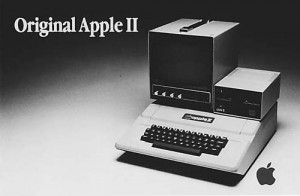
The original Apple II computer goes on sale. The Apple II featured an a 1MHz MOS 6502 processor, an integrated keyboard, a built-in BASIC programming environment, expandable memory (4K expandable to 48K), a monitor capable of color graphics, a sound card, and eight expansion slots. To include all these features in one discrete unit was highly innovative and the reason it is considered the first practical personal computer. However, in the spirit of the original computer hacker, the Apple II was also available as a circuit-board only, without keyboard, power supply, or case. A couple of years later, the combination of the Apple II series and the first “killer app” of the business world, the VisiCalc spreadsheet program, popularizes personal computers among business users. This sudden success of the “home computer” in the business world surprises established technology companies and eventually leads IBM to scramble to develop their IBM PC.
Apple Newton Announced
May 29, 1992
At the Consumer Electronics Show (CES) in Chicago, Apple Computer CEO John Sculley first announces the coming release of the Newton personal digital assistant to a group of reporters, explaining that the Newton “is nothing less than a revolution.” Although there was not a fully functioning prototype available, the Newton technology is demonstrated, including how to order a pizza by moving topping icons onto a pie and then faxing the order from the device.
The Newton is Apple’s first major new product line since the Macintosh was released eight years earlier. The Newton unveiling generates immediate buzz, but due to several factors, Sculley’s announcement will ultimately be considered a major mistake. The announcement itself tipped the company’s hand to its competitors and wildly inflated consumer expectations. The Newton’s release was delayed until August of 1993, and when it was released, it was not as user-friendly as expected. Specifically, the core hand-writing recognition feature was widely criticized as buggy and inaccurate. While the technology was greatly improved in subsequent revisions, the Newton never gained much commercial success, and shortly after his return Steve Jobs discontinued the Newton in 1998.
Apple Cube Store Opens in NYC
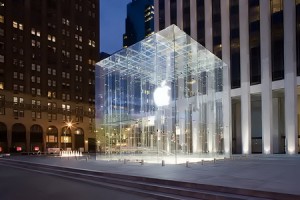
Apple opens their second store in New York City, a 20,000 square-foot shop at the underground concourse of the General Motors building at 767 Fifth Avenue. Open 24-hours a day, the shop is visible at street level through a 32-foot glass cube. Designed by Apple’s CEO Steve Jobs at a cost of $9 million, people stood in line for hours prior to the store’s opening.
Apple Debuts Retail Stores
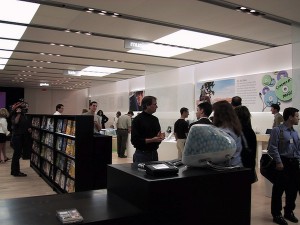
Apple Computer opens the first two locations of their new retail stores in McLean, Virginia and Washington, D.C. In the first weekend of opening, the stores will attract 7,700 shoppers and will sell a combined $599,000. While ridiculed by many technology “experts” at the time, the Apple Stores have been insanely successful and was one of the key reasons for Apple’s resurgence in the 2000’s.

